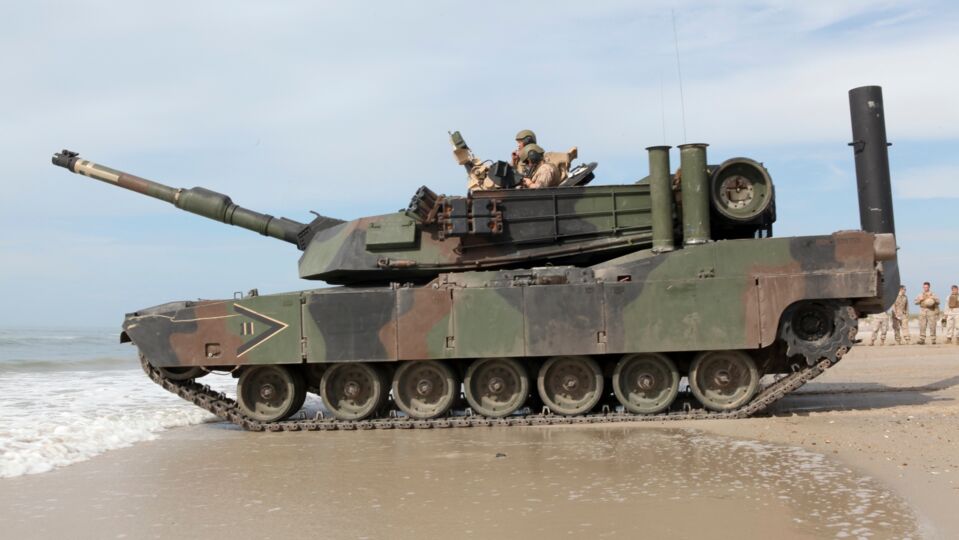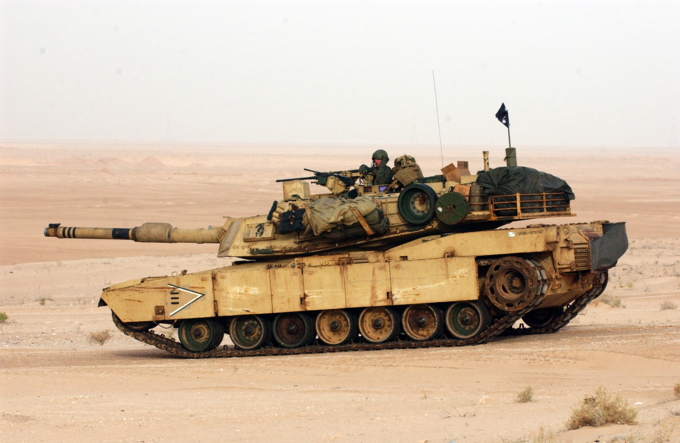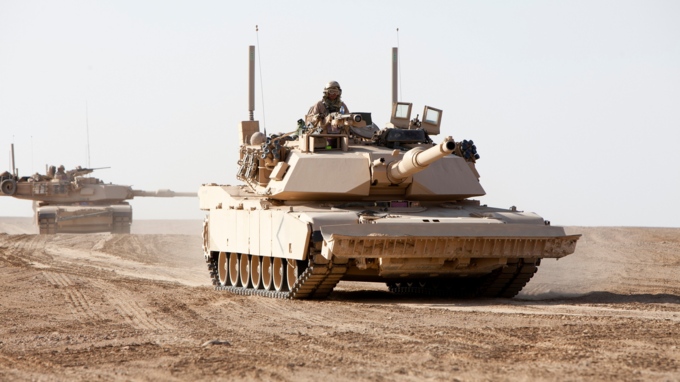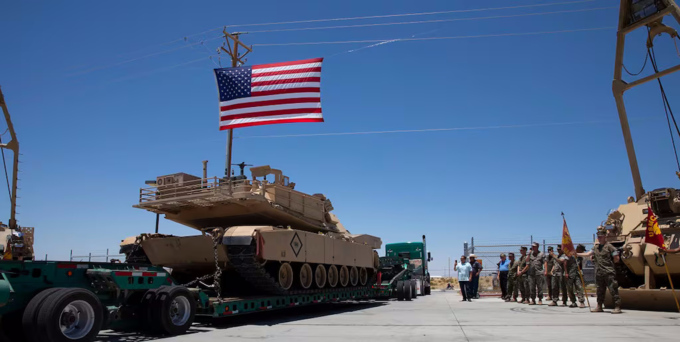The M1A1 HC tank, developed in the mid-1980s, was a tank built to accommodate changes into the M1 Abrams design for the United States Marine Corp (USMC) to replace their M60A1 tank. Production began in November 1990, incorporating changes like deep-wading adapters and stronger tie-downs. The USMC received 269 units by 1992, with additional transfers and upgrades continuing until 2005. The M1A1 HC saw sterling combat service in the USMC in the Gulf War, Iraq, and Afghanistan.
Development & Procurement
Though the M1 Abrams became accepted into service of the United States Army in November 1981, the United States Marines Corps (USMC) were not able to immediately look into procurement of the Abrams tanks due to budget constraints. It was not until February 1985 that Commandant of the Marine Corps Gen. Paul Kelly sought to officially replace the M60A1 in USMC service with the M1A1 Abrams, with plans for 490 M1A1 to replace 760 M60A1 beginning in November 1990.
The USMC's plan to acquire the M1A1 (or the M1A1 HA model with DU armor since October 1988) also requested design changes to the tank to fit the USMC's needs. These requests culminated to eighty engineering changes, such as deep-wading adapters for fording kits, stronger chain tie-downs, and a position location reference system. Instead of producing this modified Abrams tank just for the USMC, GDLS integrated these changes into the overall M1A1 HA production lines beginning in November 1990. These new M1A1s were not distinguished by the service branch, being sent to both the US Army and US Marine Corps. As such, the US Army began referring to the M1A1s produced after November 1990 as the M1A1 HC, with HC for "Heavy Common" in reference to the commonality of the M1A1 HA tank design between the service branches. The USMC came to referencing the tank as the M1A1 Common, while referring to any pre-November 1990 builds of the M1A1 HA as a "Plain Jane". The primary distinction between a US Army and a US Marine Corps M1A1 HC is the smoke grenade launchers, the US Army uses the M250 smoke grenade launcher while the USMC uses the M257 smoke grenade launcher.
Though the USMC requested for 490 M1A1 HC tanks, they would only receive 269 units by the delivery end date of 1992. An insufficient number for their needs, the USMC would receive additional support from US Congress between 1994 to 1995, which allocated enough funding for the transfer of 134 M1A1 tanks from the US Army. As these were "Plain Jane" M1A1 HAs, an upgrade program was started between 1995 to 1997 to apply "Common" design changes into the "Plain Janes". Another transfer would occur in between 2002 to 2005 for 181 M1A1 HA from the US Army to the USMC, which were likewise modified to HC standards.
Combat usage
The USMC's stock of M1A1 Abrams tank would see first use during the 1991 Gulf War. However, their primary tank deployed to the theater was the M60A1 RISE (P) as they were still procuring and transitioning to the M1A1 tanks. To bolster the US Marine's number of Abrams, the US Army provided 60 "Plain Jane" M1A1 HA to the US Marine's 2nd Tank Battalion while the two companies of the 4th Tank Battalion of the USMC Reserve was equipped with 16 of the newer M1A1 HC. As such, the Abrams made up of 76 of the total 353 USMC tanks in the Gulf War, the rest of which was composed of M60A1s.
The USMC's Abrams were committed into action during the ground phase of Operation Desert Storm. 4th Tank Battalion's Bravo Company saw action in the pre-dawn hours of February 25th when a T-72 battalion from the 3rd Saladin Armored Division approached their location. The M1A1 HCs, benefitting from their thermal imager gun sights, were able to engage and decimate the battalion, destroying up to 34 of the 35 total T-72 tanks in a span of 90 seconds. One crew was even credited with hitting seven tanks with seven rounds in about a minute.
The M1A1 HC would continue to see use wherever the USMC deployed their armoured units, such as in Operation Iraqi Freedom in Iraq and Operation Enduring Freedom in Afghanistan. The M1A1 HC's usage in Afghanistan stand out as the US Army did not bring any Abrams, and the Abrams were present from 2011 to 2013. The tanks deployed to these two operations are distinguished by the fitting of a CREWS 1 electronic receiver/jammer unit, intended to prevent the transmission of electronic frequencies from detonating improvised explosive devices (IED). These are distinguished by two large antennas usually located at the turret rear.
Further upgrades and the Future
The USMC stuck with the M1A1 HC throughout its service life, lacking the budget to upgrade to the US Army's M1A2 Abrams. However, the USMC integrated several M1A2 and other US Army features such as the Stabilized Commander's Weapon Station (SCWS) and Tank-Infantry Phone (TIP). One unique upgrade the USMC implemented on their tanks was the Abrams Suspension Upgrade (ASU), intended to improve the Abrams' supported weight to 77 tons. A Firepower Enhancement Program (FEP) was also implemented to improve the fire control system and IFF recognition.
In 2020, the United States Marine Corps was reorganized under Commandant Gen. David Berger as part of Force Design 2030, with the decision made to deactivate all tank units under the USMC. The process began in July with 4th Tank Battalion's deactivation and ended in on 21 May 2021 with the 1st Tank Battalion's deactivation. The 452 M1A1 HC tanks in USMC inventory are to be transferred to the US Army by 2023. Should tanks be required to support USMC operations in the future, it is expected that the US Army's M1 Abrams can provide the needed capabilities.
Bibliography
- Athey, Philip. "Marine Corps deactivates its final active-duty tank battalion". Marine Corps Times, 25 May 2021, Website. Accessed 14 Nov. 2021 (Archive).
- Chief of Naval Operations. "THE UNITED STATES NAVY IN "DESERT SHIELD" / "DESERT STORM" » Appendix A: Chronology - February 1991". Naval History and Heritage Command, 02 Mar. 2015, Website. Accessed 14 Nov. 2021 (Archive).
- Commandment of the Marine Corps. "Force Design 2030". Headquarters Marine Corps, 26 Mar. 2020, Website. Accessed 19 Aug. 2022 (Archive).
- Conners, Chris. "M1 Abrams". American Fighting Vehicle Database, 13 Nov. 2021, Website. Accessed 14 Nov. 2021 (Archive).
- Cooke, Gary W. "U.S. Vehicle Grenade Launchers". Gary's Place, 03 May 2008, Website. Accessed 14 Nov. 2021 (Archive).
- Green, Michael. Images of War: M1 Abrams Tanks - Rare Photographs From Wartime Archives. E-book ed., Pen & Sword Military, 2015. Kindle.
- Harkins, Gina. "Marines to Shut Down All Tank Units, Cut Infantry Battalions in Major Overhaul". Military Advantage, 23 Mar. 2020, Website. Accessed 14 Nov. 2021 (Archive).
- Harkins, Gina. "Marine Corps Begins Shutdown of All Tank Battalions". Military Advantage, 21 Jul 2020, Website. Accessed 14 Nov. 2021 (Archive).
- South, Todd. "Goodbye, tanks: How the Marine Corps will change, and what it will lose, by ditching its armor". Marine Corps Times, 22 Mar. 2021, Website. Accessed 14 Nov. 2021 (Archive).
- Zaloga, Steven J. M1 Abrams VS T-72 Ural - Operation Desert Storm 1991. E-book ed., Osprey Publishing Ltd., 2009. Kindle.





